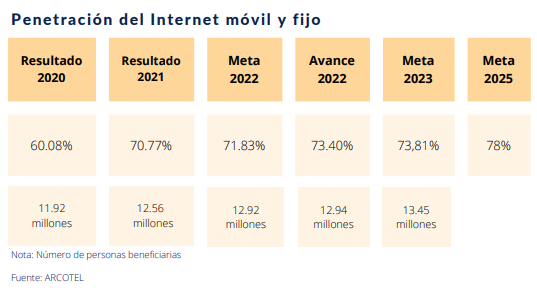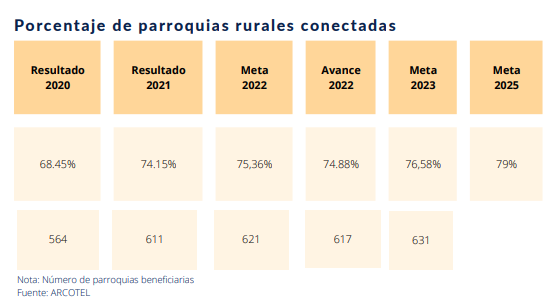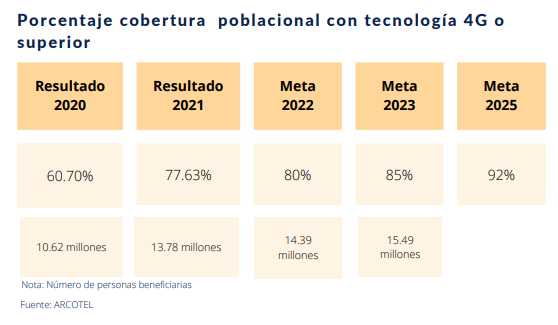Ecuador - 3.4 Telecommunications
Ecuador has the first digital transformation agenda in Latin America. The Digital Transformation Law is a true transformation of the country.
Ecuador Digital Project
In the country, the Digital and Audiovisual Transformation Law was unanimously approved, as well as the Fintech Law[1]. Both propose the creation of regulatory sandboxes to digitally promote banking, financial, insurance, and personal finance processes and services, such as wallets, metered transfers, credit cards, all to promote the digital economy.
Also the use of telematic means for notarial procedures, similar for registrations with real estate brokers, everything related to stock market intermediation. In connectivity, community networks are also promoted in rural areas so that they can use their own networks as non-governmental organizations or community media, all with very high cybersecurity components.
Although Ecuador has several fixed line operators and a large number of ISPs, the predominant state-owned CNT leads the fixed line market and, therefore, also the fixed broadband market. However, CNT's share of the fixed line market is declining year on year, while its share of fixed Internet connections has fallen below 24%.
Telephone system
General evaluation of the fixed line service and sophisticated 4G LTE ultra-broadband network; Much of the country's landline structure is influenced by the topographical challenges associated with the Andes Mountains; Ecuador has a telecommunications market with a dominant mobile sector; The state company CNT dominates the fixed line market and, therefore, also the DSL broadband market.
5G technology in Ecuador
According to information from the Global System Mobile Association (GSMA), it is expected that the new technology will begin to be commercialized in Ecuador in 2025.
Currently there are three experimental areas of this technology in the country: two in Guayaquil and one in Manta, as a prior step to the massive arrival of this disruptive technology that will become a key ally of the country's development. The fifth generation of mobile telephony is 10 times faster than the 4G network or even fiber optic connections (under optimal measurement conditions). That is, it will allow browsing at 10 gigabytes per second. For the implementation of the 5G network in its full capacity, the new spectrum bands are required to be tendered by the State, in addition, the preparation of 5G requires large investments in fiber optics, replacement of platforms, and acquisition of new networks and virtualization of components.
For more information on telecoms contacts, please see the following link: 4.11 Additional Services Contact List.
Domestic
Fixed line services with digital networks provided by multiple telecommunications operators; fixed line teledensity is approximately 15 per 100 people; Mobile phone use has increased and the number of subscribers has reached 95 per 100 people.
International
Country code - 593; landing points for the PAN-AM and South America-1 submarine cables providing links to the west coast of South America, Panama, Colombia, Venezuela and extending to Aruba and the US Virgin Islands in the Caribbean; In 2017, Alcatel completed a 6,000 km submarine cable system from Sarasota, Florida, to Manta, Ecuador; satellite earth station - 1 Intelsat (Atlantic Ocean)
International links
There are two fiber optic cables that connect Ecuador with some other countries in America: The Pan American cable (PAN-AM) is a submarine telecommunications cable system that connects the west coast of South America and the Caribbean, crossing the continent through Panama. It has landing points in: Arica, Province of Arica, Region of Arica and Parinacota, Chile; Lurín, Lima Region, Peru; Punta Carnero, Guayas Province, Ecuador; Pratt Battery, Colón Province, Panama; Barranquilla, Department of Atlántico, Colombia; Punto Fijo, Falcón State, Venezuela; Baby Beach, Aruba; St. Croix, US Virgin Islands
SAM-1
It is an optical submarine communications cable. It began operations in 2000, connecting the United States, Puerto Rico, Brazil, Argentina, Chile, Peru and Guatemala. In 2007, SAm-1 was expanded to reach Ecuador and Colombia.
|
Telephone Services |
|
|---|---|
|
Is there an existing landline telephone network? |
Yes |
|
Does it allow international calls? |
Yes |
|
Number and Length of Downtime Periods (on average) |
N/A |
|
Mobile Phone Providers |
Conecel S.A (Claro), Otecel (Movistar) CNT |
|
Approximate Percentage of National Coverage |
|
Ecuador ended November 2022 with 1.8 million fixed telephone lines. CNT leads the market with an 83% share, followed by Etapa (6.59%), Claro (5.15%), Setel (3.70%), CenturyLink (0.94%) and Linkotel (0.64). %).
Telecommunications Regulations
The ARCOTEL Telecommunications Regulation and Control Agency is the entity in charge of the administration, regulation and control of telecommunications and the radio spectrum and its management, as well as the technical aspects of the management of social media that use frequencies. of the radio spectrum or that install and operate networks.
Thuraya, Began equipment, satellite phones and satellite modems, and VHF, UHF and HF two-way radios, wireless phones for fixed service. For example, CDMA 450 or Wimax require approval. Likewise, those devices that allow direct access to the Internet wirelessly. e.g. Access Point.
Exceptions are computers, laptops, printers, audio and video consoles or other foreign equipment that connects indirectly and wirelessly to the Internet.
|
Regulations on Usage and Import |
||
|---|---|---|
|
Regulations in Place? |
Regulating Authority |
|
|
Satellite |
Yes |
ARCOTEL |
|
HF Radio |
Yes |
ARCOTEL |
|
UHF/VHF/HF Radio: Handheld, Base and Mobile |
Yes |
ARCOTEL |
|
UHF/VHF Repeaters |
Yes |
ARCOTEL |
|
GPS |
n/a |
|
|
VSAT |
Yes |
ARCOTEL |
|
Individual Network Operator Licenses Required |
||
|
Yes |
||
|
Frequency Licenses Required |
||
|
Yes |
||
Existing Humanitarian Telecoms Systems
In Ecuador the United Nations system has some shared telecommunications infrastructure. This equipment is located throughout Ecuadorian territory. This equipment includes VHF repeaters, VSAT stations and other telecommunications devices. A summary of this equipment is detailed in the following chart:
|
Existing UN Telecommunication Systems |
|||
|---|---|---|---|
|
UNDP |
WFP |
UNHCR |
|
|
VHF Frequencies |
X |
X |
X |
|
HF Frequencies |
X |
X |
X |
|
Locations of Repeaters |
Quito (2) |
ESMERALDAS, TULCAN, SAN LORENZO, LAGO AGRIO |
|
|
VSAT |
|
X |
|
Internet Service Providers (ISPs)
WiFi
Quito and Guayaquil offer the widest range of options to connect away from home. In addition to the hundreds of Internet cafes, WiFi is available in large shopping centers and airports, as well as in some restaurant chains and large hotels.
Mobile Internet in Ecuador
When choosing a monthly mobile package from any of the major providers, you'll probably get a certain amount of mobile data included. A pay-as-you-go SIM from any of the major networks should also get you online, as long as the phone has internet capability.
Internet speed test in Ecuador
https://www.speedtest.net/global-index/ecuador
https://www.speedtest.net/global-index/ecuador?city=Quito
Internet Penetration in Ecuador
According to Internet World Stats, Ecuador has one of the highest levels of Internet penetration in Latin America.

According to the Institute of Statistics and Censuses (INEC), only 16.6% of the country's rural population has access to fixed internet. According to INEC data, there is a gap of 20.6% between the urban area and the rural area of Ecuador.

The internet services market is led by:
• CNT with 31.3% of the market
• Megadata (22.5%)
• Conecel (12.1%)
• Setel (11.3%)
• Puntonet (4.61%)
• Stage (3.09%)
• Telconet (1.14%).
CNT (National Telecommunications Corporation) is the public telecommunications company of Ecuador that offers local, regional and international fixed telephony services, Internet Access (Dial-Up, DSL, mobile Internet), satellite television and mobile telephony in Ecuadorian territory.
Ref. https://www.bnamericas.com/es/noticias/radiografia-al-mercado-de-telecomunicaciones-de-ecuador
The fixed broadband speeds in the country are 24.54 Mbps (download) and 21.11 Mbps (upload) and in the mobile service the download speed is 22.39 Mbps and the upload speed is 10.63 Mbps.
|
Internet Service Providers |
||
|---|---|---|
|
Are there ISPs available? |
Yes |
|
|
If yes, are they privately or government owned? |
Yes, one (1) CNT is Government property |
|
|
Dial-up only? |
No |
|
|
Approximate Rates (local currency and USD - $) |
Dial-up |
N/A |
|
Broadband |
50 Mb USD 24.6 70 Mb USD 28, 100 Mb USD 39.- 300 Mb USD 55.- |
|
|
Max Leasable ‘Dedicated’ Bandwidth |
100 mbps |
|
The latest ARCOTEL internet access figures, as of September 2022, show 2.5 million fixed broadband lines, with a penetration of 14.4%.
CB Vision - Paute. Internet provider and optic fiber https://www.cbvision.net.ec/index.php/tr/ Tel: 096 100 3000 https://cbvision.net.ec/index.php/en/empresa/about/paute
Claro Ecuador - Quito. Internet Provider. https://claro.com.ec/
Clicknet - Latacunga. Internet services providert. https://clicknet.ec/
CNT - Quito. https://www.cnt.com.ec/
Electrocom - Guayaquil. https://www.electrocom.ec/ PBX (5934) 605-2435.
Extreme - Ambato. https://extreme.net.ec/ Tel: 096315599 / 0995855757
Fibramax - Quito. https://fibramax.ec/ Tel: 099 20 20 600
Grupo SEICOM - Naranjal. www.grupo-seicom.webnode.com.ec Tel: 0960580683
Mobile Network Operators (MNOs)
The Mobile Telephony operators that operate in Ecuador are Conecel S.A (Claro), Otecel (Movistar), CNT and Virgin Mobile.
Claro leads the market with a share of 51.7%, followed by Movistar with a share of 30.7% and CNT with 17.6%.

5G technology in Ecuador
According to information from the Global System Mobile Association (GSMA), it is expected that the new technology will begin to be commercialized in Ecuador in 2025.
In November 2023, Motorola relaunched its entire portfolio in Ecuador. The brand will have a direct presence in all retail chains and operators, and through partners and distributors. 80% of the portfolio that will be presented is 5G. Part of Motorola's entry into Ecuador in this new stage is to encourage the development of 5G technology and grow the industry in the country. At the close of this edition, no new progress has been recorded in its implementation.
For information on MNOs please visit the GSM Association website.
|
Company |
Number of Agent Outlets by Area |
Network Strength by Area |
Contracted for Humanitarian or Government Cash Transfer Programmes? |
Services Offered (i.e. Merchant Payment, Bulk Disbursement, Receive & Make Payment) |
|---|---|---|---|---|
|
Claro |
Nationwide |
N/A |
Yes, for users, public payments, money transfers, disbursements, etc. |
|
|
Movistar |
Nationwide |
N/A |
Yes, for users, public payments, money transfers, disbursements, etc. |
|
|
CNT Ecuador |
Nationwide |
N/A |
Yes, for users, public payments, money transfers, disbursements, etc. |
Disclaimer: Inclusion of company information in the LCA does not imply any business relationship between the supplier and WFP / Logistics Cluster, and is used solely as a determinant of services, and capacities.
Please note: WFP / Logistics Cluster maintain complete impartiality and are not able to endorse, comment on any company's suitability as a reputable service provider.
[1] The Fintech Law in Ecuador, as the Organic Law for the Development and Control of Technological Financial Services is known: “allows the entry of other participants to the provision of financial services, seeking the financial inclusion of citizens who have not been able to access traditional banking” The novel aspects that this Law brings to the Ecuadorian financial system is based on the creation of new means of payment that work with a technological infrastructure, technological financial services, the creation of specialized electronic deposit and payment companies. On December 22, 2022, the so-called Fintech Law was published in the Official Registry, Second Supplement 215.